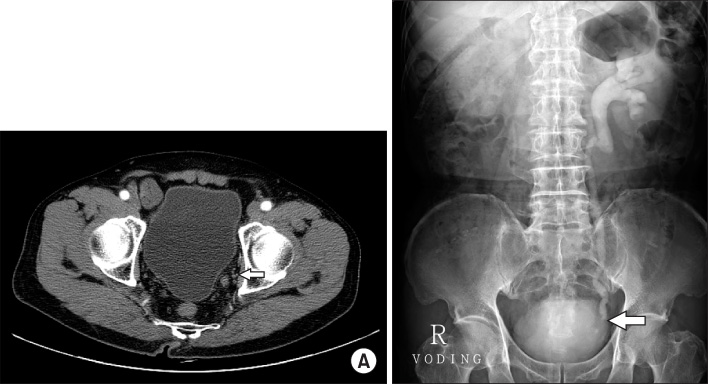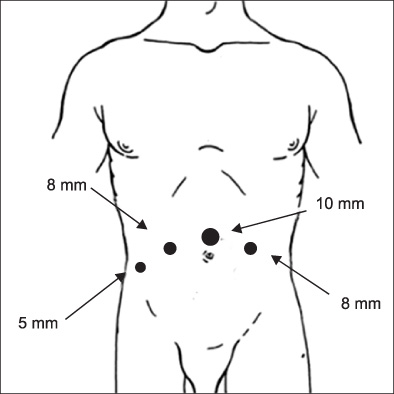Korean J Urol.
2009 Sep;50(9):921-924.
Robot-Assisted Laparoscopic Distal Ureterectomy and Ureteral Reimplantation
- Affiliations
-
- 1Department of Urology, Korea University School of Medicine, Seoul, Korea. mdksh@korea.ac.kr
Abstract
- We report here on our technique and outcomes of the first case of robot-assisted laparoscopic distal ureterectomy with a bladder cuff excision and ureteroneocystostomy. A 74-year-old male patient who had a distal ureter tumor underwent robot-assisted transperitoneal distal ureterectomy. After distal ureterectomy with bladder cuff excision was performed, direct ureteroneocystostomy was performed. The whole procedure was successfully performed by using the robot without conversion to open surgery. The total operative time was 207 minutes, and the estimated blood loss was 30 ml. The final pathological examination showed stage T2 invasive transitional cell carcinoma of the distal ureter. The patient's postoperative recovery was uneventful and the bladder cuff was free of tumor. Robot-assisted laparoscopic distal ureterectomy with ureteroneocystostomy is safe and feasible and offers patients the advantages of minimally invasive surgery.
Keyword
MeSH Terms
Figure
Reference
-
1. Flanigan RC. Wein AJ, Kavoussi LR, Novick AC, Partin AW, Peters CA, editors. Urothelial tumors of the upper urinary tract. Campbell-Walsh urology. 2007. 9th ed. Philadelphia: Saunders;2932–2938.2. Raman JD, Scherr DS. Management of patients with upper urinary tract transitional cell carcinoma. Nat Clin Pract Urol. 2007. 4:432–443.3. Lee YS, Han WK, Yang SC, Rha KH. Robot-assisted laparoscopic radical prostatectomy. Korean J Urol. 2006. 47:206–210.4. Lay F, Nahon O, Neuzillet Y, Lechevallier E, Coulange C. Contribution of laparoscopy to vesico-ureteral reimplantation on vesico-psoas. Prog Urol. 2003. 13:518–522.5. Modi P, Goel R, Dodiya S. Laparoscopic ureteroneocystostomy for distal ureteral injuries. Urology. 2005. 66:751–753.6. Nezhat CH, Malik S, Nezhat F, Nezhat C. Laparoscopic ureteroneocystostomy and vesicopsoas hitch for infiltrative endometriosis. JSLS. 2004. 8:3–7.7. Symons S, Kurien A, Desai M. Laparoscopic ureteral reimplantation: a single center experience and literature review. J Endourol. 2009. 23:269–274.8. Roupret M, Harmon JD, Sanderson KM, Barret E, Cathelineau X, Vallancien G, et al. Laparoscopic distal ureterectomy and anastomosis for management of low-risk upper urinary tract transitional cell carcinoma: preliminary results. BJU Int. 2007. 99:623–627.9. Uberoi J, Harnisch B, Sethi AS, Babayan RK, Wang DS. Robot-assisted laparoscopic distal ureterectomy and ureteral reimplantation with psoas hitch. J Endourol. 2007. 21:368–373.10. Glinianski M, Guru KA, Zimmerman G, Mohler J, Kim HL. Robot-assisted ureterectomy and ureteral reconstruction for urothelial carcinoma. J Endourol. 2009. 23:97–100.
- Full Text Links
- Actions
-
Cited
- CITED
-
- Close
- Share
- Similar articles
-
- Robot-assisted distal ureteral reconstruction for benign pathology: Current state
- Lessons learned over a decade of pediatric robotic ureteral reimplantation
- Surgical outcomes for robot-assisted laparoscopic myomectomy compared with laparoscopic myomectomy
- Erratum: Robot-Assisted Laparoscopic Radical Prostatectomy
- Cohen Ureteral Reimplantation: Outcome of 58 Ureters in 34 Children





